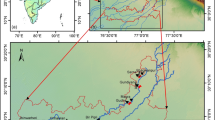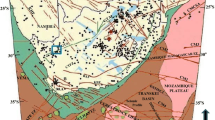Abstract
On June 3, 2010, a series of karst sinkholes occurred at Jili village surrounded by Gui-Bei highway, Wu-Ping highway and Nan-Liu High-Speed Railway in Laibin, Guangxi, China. The straight-line distances from an large sinkhole pit, 85 m in diameter and 38 m in depth, to the above mainlines are 200, 600 and 500 m, respectively. Several investigation methods including geophysical technology, borehole and well drilling, groundwater elevation survey and hydrochemistry analysis of groundwater were used to study the formation mechanisms of these sinkholes. Based on the results, the spatial distribution of the Jili underground river was confirmed with a strike of SN along the middle Carboniferous limestone bedrock and the Quaternary deposits controlled the sinkhole formation. In addition, both historical sinkhole events and analysis of the groundwater–air pressure monitoring data installed in the underlying karst conduit system indicate that sinkholes in this area are more likely induced by extreme weather conditions within typical karst geological settings. Extreme weather conditions in the study area before the sinkhole collapses consisted of a year-long drought followed by continuous precipitation with a daily maximum precipitation of 442 mm between May 31 and June 1, 2010. Typical geological conditions include the Jili underground river overlain by the Quaternary overburden with thick clayey rubble. Especially in the recharge zone of the underground river, a stabilized shallow water table was formed in response to the extreme rainstorm because of the presence of the thick clayey rubble. When the underground conduit was flooded through the cave entrance on the surface, air blasting may have caused the cave roof collapse followed by formation of soil cavities and surface collapses. Borehole monitoring results of the groundwater–air pressure monitoring show that the potential karst sinkhole can pose threats to Shanbei village, the High-Speed Railway and the Wu-Ping highway. Local government needs to be aware of any early indicators of this geohazard so that devastating sinkholes can be prevented in the future. The results also suggest that groundwater–air pressure monitoring data collected both the Quaternary deposits and the bedrock karst system provide useful indicators for potential sinkhole collapses in similar karst areas where sinkholes usually occur during rainy season or karst groundwater level is always under the rockhead.











Similar content being viewed by others
References
Bai AZ, Chen JL, Shi J, Jiang RG (2010) The investigation report of ground collapse geohazards in Jili village, Laibin, Guangxi province (in Chinese)
Benson RC, Yuhr LB (2016) Site characterization in karst and pseudokarst terraines. Triggering mechanisms for sinkholes. Springer, Dordrecht
Chen J, Beck BF (1995) Mechanical impacts of air and water compression in karst conduits. In: Proceedings of the 5th multidisciplinary conference on sinkholes and the engineering and environmental impacts of karst: karst geohazards, Gatlinburg, Tennessee. Balkema, Rotterdam, pp 17–22
Clint K, Baker AE (2015) Sinkhole vulnerability mapping: results from a pilot study in north central florida. In: Proceedings of the 14th multidisciplinary conference on sinkholes and the engineering and environmental impacts of karst: NCKRI symposium 5, pp 241–254
Currin JL, Barfus BL (1989) Sinkhole distribution and characteristics in Pasco County, Florida. In: Proceedings of the 3rd multidisciplinary conference on sinkholes and the engineering and environmental impacts of karst: karst geohazards, Gatlinburg, Tennessee. Balkema, Rotterdam, pp 97–106
Gao Y, Luo W, Lei M (2013) Investigations of large scale sinkhole collapses, Laibin, Guangxi, China. In: Proceedings of the 13th multidisciplinary conference on sinkholes and the engineering and environmental impacts of karst: NCKRI symposium 2, pp 327–331
Gertje H, Jeremias AE (1989) Building construction over an erosive sinkhole site: a case study in Lancaster County, Pennsylvania, USA. In: Proceedings of the 3rd multidisciplinary conference on sinkholes and the engineering and environmental impacts of karst: karst geohazards, Gatlinburg, Tennessee. Balkema, Rotterdam, pp 311–318
Gutierrez F, Cooper AH, Johnson KS (2008) Indentification, prediction, and mitigation of sinkhole hazards in evaporate karst areas. J Environ Geol 2008(53):1007–1022
He Y, Xu C (1993) The water dynamic factor of karst sinkhole. J Hydrogeol Eng Geol 05:39–42 (in Chinese)
Lamoreaux PE (1984) Catastrophic subsidence: Shelby County, Alabama. In: Proceedings of the 1st multidisciplinary conference on sinkholes: karst geohazards, Gatlinburg, Tennessee. Balkema, Rotterdam, pp 131–136
Liu W, Gan FP, Zao W, Chen YL (2014) Application analysis of combining high density resistivity and microtremor survey methods in areas of karst collapse: a case study of the collapse in Jili village, Laibin, Guangxi. J Carsologica Sinica 33(1):118–122 (in Chinese)
Luo W, Yuanbin W, Jianling D (2016) The investigation report of karst sinkhole hazard mapping in scale of 1:50,000 in Laibin. The Institute of Karst Geology, Guilin (in Chinese)
Tharp TM (1999) Mechanics of upward propagation of cover-collapse sinkholes. J Eng Geol 52(1999):23–33
Wilson WL (1991) The new picture of sinkhole development in Florida. The Florida Specifier, Feb, Goldenrod, Florida
Zhou G, Chen K, He S, Yue T (2014) Analysis of spatial and temporal distribution characteristics of karst collapse in Laibin. J Geom Spat Inf Technol 37(4):3–7 (in Chinese)
Acknowledgement
This study is supported by the National Natural Science Foundation of China (41472298, 41272355) and Special Funds of MLR for public welfare projects (No. 201211083) and China Scholarship Council (201508450007) and Meteorological Information Center of China.
Author information
Authors and Affiliations
Corresponding author
Additional information
This article is a part of the Topical Collection in Environmental Earth Sciences on Karst Hydrogeology: Advances in Karst Collapse Studies, edited by Dr. Zhou Wanfang.
Rights and permissions
About this article
Cite this article
Jiang, X., Lei, M. & Gao, Y. Formation mechanism of large sinkhole collapses in Laibin, Guangxi, China. Environ Earth Sci 76, 823 (2017). https://doi.org/10.1007/s12665-017-7128-1
Received:
Accepted:
Published:
DOI: https://doi.org/10.1007/s12665-017-7128-1




